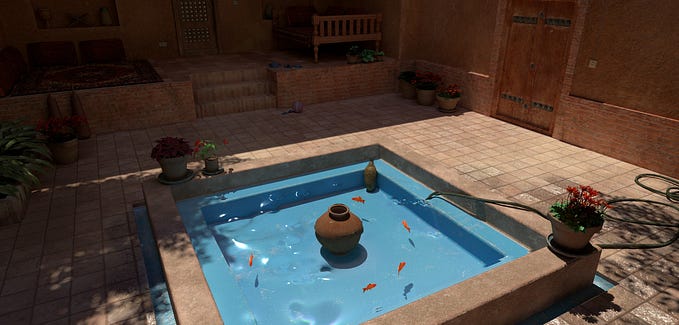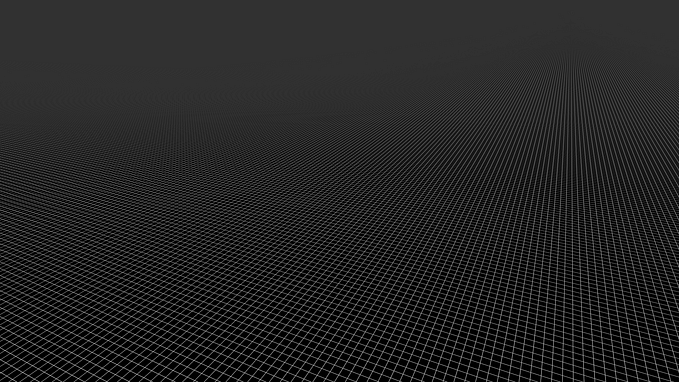Look At Transformation Matrix in Vertex Shader
A look at transformation matrix for animating statues without rigging in Unity 3D

I am going to present how to make a look at transformation matrix for vertex shader. Although the technique can be used in any environment, I will be using some specific utilities of Unity Engine.
As usual you can find the code on Github: https://github.com/IRCSS/Look-At-Transformation-Matrix
Motivation
The other day, I was thinking about making a horror like VR mini experience. In the exprience the statues look at you when you are not directly looking at them, and look away once you do. I got the inspiration from an art installation in Berlin. As this idea was added to the long and ever increasing list of 'To Do Projects’, I started thinking about how I would implement this.
The standard way of doing stuff like these is of course rigging. There is no reason why this rigging needs to happen in a 3D editing software though. Considering the fact that I need only one pivot per statue, I decided to implement this directly in Unity.
The idea would be to use the Transform of an empty Gameobject to determine the rotation-pivot’s position and orientation and an empty game object as look at target. Using the two, a look at transformation matrix can be created and used in the vertex shader. Since I don’t want to rotate the entire thing, just the head, I would need to blend between the normal MVP and look at transformations.
Simple enough. Before jumping to the implementation, let me define some common terminology.
So we want the mesh A to rotate around its pivot, in a way that the statue’s forward direction aligns with the vector that goes from the pivot to the look at target. I will call this vector LookAt and the statue’s forward as sForward.

Gram Schmidt
My first idea was to use Gram Schmidt to create an orthonormal coordinate system, in which I can rotate the head in a way, that the forward vector of the head aligns with the LookAt vector. I won’t duel on this method, because I switched to using cross products. I will post the code though, so you can have a look at this as an alternative.
There are two main problems with this approach, one was that the coordinate system was free to switch between left and right handed coordinate system, which caused the mesh to flip (look at figure 4). This can be fixed by making sure the sign of the determinant of the matrix doesn’t change. The second problem was that I need at least 2 vectors to have a temporally coherent coordinate systems for my rotation. Realizing I am making things too complicated, I switched to using cross products.
Cross Products
As I was playing around with Gram Schmidt, I realized there is no reason to create a coordinate system to rotate the mesh, transform in that coordinate system, rotate and then transform back to world space. If I transform the mesh in a space, which has a column space where the z axis aligns with the LookAt vector, I can simply transform the coordinates from here to the clip space of the camera and everything will look fine. If this is not making any sense to you, I suggest reading my post on affine and non affine transformation matrices.
I am going to go through this a matrix at the time. The top down view is this, we construct a matrix in the CPU, which rotates the mesh in a way, so that it is looking at an object we desire, around a pivot we provide. This transformation matrix also transforms the mesh in the clip space of the camera for further processing in the GPU pipeline. The matrix is provided as a uniform to the vertex shader and there the actual calculations happen. Here is the general formula for creating this matrix, we will go through it a matrix at a time:
Matrix4x4 objectToClip = GL.GetGPUProjectionMatrix(cam.projectionMatrix, true)
* cam.worldToCameraMatrix * modelFoward.localToWorldMatrix
* lookAtMatrix* modelFoward.worldToLocalMatrix
* renderOfTheMesh.localToWorldMatrix;Mesh Model Matrix
In the way Unity is set up (column major form), the matrix which is the most right is the transformation that happens first. This is the localToWorldMatrix of the renderer of our mesh. Do we need this transformation? I wanted to have this in, so that I can still rotate, scale and translate my mesh using the game object it is attached to. Specially for photogrammetry, since meshes tend to come in with the weirdest rotations based on the pipeline they went through. So that’s all this matrix does, it takes the transform of the mesh Game object and adds its transformation as the first thing to our matrix.
ModelFoward WorldToLocalMatrix
How should our transformation know which way is forward for our statue? If we apply our Look At transfromation matrix simply in world space, it will make it so that the global forward, aligns itself with our LookAt vector. Since we want sForward to be aligned with LookAt, we first have to transform from world space to a space where sForward is the Z axis. This is what this world to local matrix does. I am simply using an empty game object for this. I rotate the empty game object in a way, so that its Z axis points toward what I think is foward for the statue (a vector that points where the statue is looking at). This vector also in codes the position of our pivot. It moves the mesh in a way, so that our pivot on the mesh, lay on the origin of our coordinate system. Since we wish to rotate around this pivot, after all your head also rotates around a point on your neck and not around your feet. If you want to know how to make this matrix yourself, look at my post on non affine matrices, I cover the construction of the model matrix there.
LookAt Matrix
This is our actual look at. Making this matrix is super simple. You need to create a space, where the forward (Z-Axis) is the LookAt vector. The other two vector you should choose in a way, so that model up remains up. You can simply do this with three cross products.
Vector3 lookAtVector = modelFoward.worldToLocalMatrix*(LookAt.transform.position — modelFoward.transform.position).normalized ;
Vector3 coordRight = Vector3.Cross(Vector3.up, lookAtVector).normalized;
Vector3 coordUp = Vector3.Cross(lookAtVector, coordRight).normalized;For your forward/ z axis, you take the LookAt vector which you can calculate by subtracting the target position from the pivot position and normalizing.
Your right/ x vector is a result of your desired up vector and the LookAt. Remember not to change this order, as you will get a flipped coordinate system. If your model/ desired up is not the global up, you obviously need to provide that.
Your up/ y is then simply a cross product of x and z axis.
Worth mentioning is that I am transforming the Z axis into our pivot space. This the space where the direction the statue is looking at is forward. The reason why I do this, is at the time where this transformation is taking place, the vertices are in this pivot space coordinate system, so should every vector/ position we use for calculations (I should do the same thing for Vector3.Up, but in my case the up remains the same in all of the spaces). I am also encoding a scaling in this matrix, because I thought I might want to scale the mesh along the LookAt later for funny effects.
ModelFoward LocalToWorldMatrix
Now that our look at is finished, we need to transform back in to world space from our pivot space. Why? Because we don’t know how to go directly from the pivot space in to camera space. Our camera is defined in terms of world coordinates. That is what this transformation does.
VP Matrix
The last two matrices are the World to Camera and Projection matrix. This I have covered else where, all it does is brings our vertex coordinates from world space in the space which is used for displaying them. I am using the GL.GetProjectionMatrix, because unity documentation says I should (probably Camera.ProjectMatrix remains the same for different platforms or APIs, whereas the actual projection matrix which is used in the GPU is different for different scenarios).
Vertex Shader and Blending
So we have our matrix, we pass it to the vertex shader. If we use this instead of UNITY_MATRIX_MVP, the entire mesh will be rotated around the pivot. This is not what we want, because only the head should rotate itself. I solved this by simply lerping between the two transformations based on the Y value of the vertex, but you can use vertex color or any other thing you can think of.
o.vertex = mul(_oToC, float4(v.vertex.xyz, 1.));
float transition = smoothstep(-.2, 1., v.vertex.z);
o.vertex = lerp( UnityObjectToClipPos(v.vertex), o.vertex, transition * _debugOrignalPosition);I hope you enjoyed reading this post, you can follow me on my Twitter IRCSS






